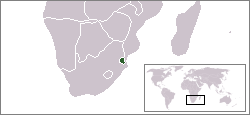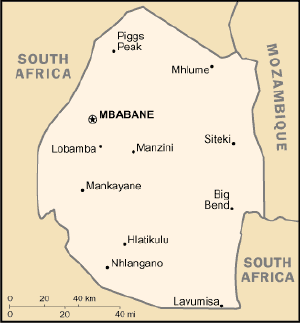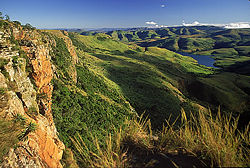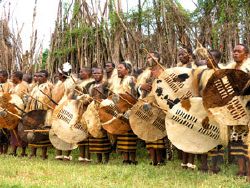Swaziland
| Umbuso weSwatini Kingdom of eSwatini |
||||||
|---|---|---|---|---|---|---|
|
||||||
| Motto: "Siyinqaba"  (Swati) "We are a fortress" "We are a mystery/riddle" "We hide ourselves away" |
||||||
| Anthem: Nkulunkulu Mnikati wetibusiso temaSwati Oh God, Bestower of the Blessings of the Swazi |
||||||
| Capital | Lobamba (royal and legislative) Mbabane (administrative; coordinates below) | |||||
| Largest city | Mbabane | |||||
| Official languages | English, Swati | |||||
| Demonym | Swazi | |||||
| Government | Unitary parliamentary democracy within Constitutional and Absolute monarchy | |||||
|  -  | King | Mswati III | ||||
|  -  | Ndlovukati | Queen Ntombi | ||||
|  -  | Prime Minister | Barnabas Sibusiso Dlamini | ||||
|  -  | Deputy Prime Minister | Themba N. Masuku | ||||
| Legislature | Parliament of Swaziland | |||||
|  -  | Upper House | Senate | ||||
|  -  | Lower House | House of Assembly | ||||
| Independence | ||||||
|  -  | from the United Kingdom | 6 September 1968  | ||||
| Area | ||||||
|  -  | Total | 17,364 km² (157th) 6,704 sq mi  |
||||
|  -  | Water (%) | 0.9 | ||||
| Population | ||||||
|  -  | July 2017 estimate | 1,467,152[1] (154th) | ||||
|  -  | 2007 census | 1,018,449  | ||||
|  -  | Density | 84.5/km² (135th) 218.8/sq mi |
||||
| GDP (PPP) | 2017 estimate | |||||
|  -  | Total | $11.352 billion[2]  | ||||
|  -  | Per capita | $9,896[2]  | ||||
| GDP (nominal) | 2017 estimate | |||||
|  -  | Total | $3.938 billion[2]  | ||||
|  -  | Per capita | $3,432[2]  | ||||
| Gini (2015) | 49.5  | |||||
| Currency | Lilangeni (SZL) |
|||||
| Time zone | SAST (UTC+2) | |||||
| Internet TLD | .sz | |||||
| Calling code | +268 | |||||
| Estimates for the country explicitly take into account the effects of excess mortality due to AIDS; this can result in lower life expectancy, higher infant mortality and death rates, lower population and growth rates, and changes in the distribution of population by age and sex than would otherwise be expected. | ||||||
The Kingdom of Swaziland (Swazi: Umbuso weSwatini), or the Kingdom of eSwatini, in southern Africa, is one of the smallest nations on the African continent, with its total area equaling just over 6,700 sq miles (17,000 square km) and a population estimated in 2005 as slightly more than 1 million (a drop from its 2001 census of nearly 1.2 million). It is situated on the eastern slope of the Drakensberg mountains, embedded between South Africa in the west and Mozambique in the east.
Swaziland consists mostly of high plateaus and mountains with an array of diverse vegetation at every turn, surprising variety for a nation its size. Sometimes referred to as the "Switzerland of Africa," the country has magnificent mountain scenery with unique, ancient rock formations which are a source of fascination for geologists and scholars.[3]
In 1949 the British government rejected a South African request for control of this small, landlocked nation. Independence was granted in 1968. The death of King Sobhuza in 1982 led to the coronation of 18-year-old King Mswati III in 1986. The king is an absolute monarch with supreme executive, legislative, and judicial powers. Nearly 60 percent of Swazi territory is held by the crown.
Present-day Swaziland, through its ancient Bantu and Nguni origins, easily accepts the concept of royal leadership. This is reflected in the status accorded to the King and Queen Mother, in a unique dual monarchy. Ruled autocratically by sub-Saharan Africa's last absolute monarch, who lives lavishly while two-thirds of the people survive on less than two dollars a day, it is largely agriculturally supported. Political parties and demonstrations are banned. The prevalence rate of HIV/AIDS is the highest in the world.
History
Human remains and artifacts from more than 100,000 years ago have been found in Swaziland. Evidence of agriculture and iron use dates from about the fourth century, and people speaking languages ancestral to current Sotho and Nguni languages began settling no later than the eleventh century.
According to traditional lore, the people of the present Swazi nation descend from the southern Bantu who migrated south from central Africa in the fifteenth and sixteenth centuries to what is now Mozambique. Following a series of conflicts with people living in the area of modern Maputo, the Swazis settled in northern Zululand about 1750. Unable to match the growing Zulu strength, the Swazis moved gradually northward in the 1800s and established themselves in the area of modern Swaziland. As the Zulu raids of the early nineteenth century, known as the mfecane or difaqane, dispersed surrounding tribes, the Swazis consolidated their hold over their mountain fastness under several able leaders. The founding father was Sobhuza I, of the ruling Dlamini clan. Under his leadership, they expanded their territory to the northwest and stabilized the southern frontier with the Zulus. In self-defense, the Swazis adopted some of the military innovations that had empowered the Zulus. The nation takes its name from his son, Mswati II.
Early in Mswati's reign he asked British authorities in South Africa for assistance against Zulu raids into Swaziland. It also was during Mswati's reign that the first whites settled in the country as the Boers moved north to avoid British rule. Following his death, the Swazis reached agreements with British and South African authorities over a range of issues, including independence, claims on resources by Europeans, administrative authority, and security. South Africans administered Swazi interests from 1894 to 1902. In 1902 Swaziland became a British protectorate and thus maintained its territorial identity.
In the early years of colonial rule, the British had expected that Swaziland would eventually be incorporated into South Africa. After World War II, however, South Africa's intensification of racial discrimination induced the United Kingdom to prepare Swaziland for independence. Political activity intensified in the early 1960s, but the largely urban parties had few ties to the conservative rural areas, where the majority of Swazis lived.
The country was granted independence on September 6, 1968. Since then, Swaziland has seen a struggle between pro-democracy activists and the totalitarian monarchy. All political parties are banned.
In 2007, the Coordinating Assembly of Non-Governmental Organizations (CANGO) listed the problems facing the nation as poverty, HIV/AIDS, food security, governance, employment, corruption, and gender-based violence. It complained that the government's failure to respect the nation's NGOs was hindering their ability to address the nation's humanitarian crisis and called for fiscal transparency and accountability and a shift in spending priorities to allocate more funds for education and health. CANGO said donors were avoiding Swaziland because of its lack of democratic reforms and transparency.
On April 19, 2018, the King of Swaziland, Mswati III, announced that the Kingdom of Swaziland had renamed itself to the Kingdom of eSwatini.[4]
Politics
The head of state is the king, who since 1986 has been King Mswati III. By tradition, the king holds supreme executive, legislative, and judicial powers. The king not only appoints the prime minister‚ÄĒthe head of government‚ÄĒbut also a small number of representatives for both chambers of the Libandla (parliament). The Senate consists of thirty members, while the House of Assembly has sixty-five seats, fifty-five of which are occupied by elected representatives, but since political parties are banned, they run as individuals.
The 1968 constitution was suspended in 1973. In 2001 King Mswati III appointed a committee to draft a new constitution. It was signed by the king in July 2005 after sections he objected to had been changed. The new constitution reaffirms his authority over the government and legislature and was strongly criticized by civil society organizations in Swaziland and human rights organizations elsewhere. It went into effect in 2006, the first constitution in over thirty years. Students and labor unions are beginning to be restive under the king's tight control.
King Mswati III is often criticized for living lavishly in a nation that is afflicted by the world's highest HIV infection rate. His fleet of luxury cars and millions spent on refurbishing his numerous wives' luxury mansions are at odds with the approximately 34 percent of the nation that stand unemployed, nearly 70 percent of whom live on less than a dollar a day, and with around 40 percent of adults afflicted by HIV.
Economy
In this small, landlocked economy, subsistence agriculture or livestock herding occupy more than 80 percent of the population. Most of the land is held in trust for the nation by the monarchy. The manufacturing sector has diversified since the mid-1980s. Sugar and wood pulp remain important foreign exchange earners. Mining has declined in importance in recent years, with only coal and quarry stone mines remaining active.
Surrounded by South Africa, except for a short border with Mozambique, Swaziland is heavily dependent on South Africa, from which it receives nine-tenths of its imports and to which it sends more than two-thirds of its exports. Customs duties from the Southern African Customs Union and worker remittances from South Africa substantially supplement domestically earned income. But the customs fees will be lost when regional trade reforms take effect. To compensate, the government is trying to build up the transportation and tourism sectors.
It is also trying to improve the atmosphere for foreign investment. But even the textile factories built to take advantage of special benefits moved on to China and India with the removal of import quotas on textiles. The prime minister predicted a growth rate of 2.8 percent for 2006; critics doubted that was realistic. The Central Bank of Swaziland said at least 2.9 percent economic growth was needed to match population growth and maintain Swazis' standard of living.
Overgrazing, soil depletion, drought, and sometimes floods persist as problems for the future. In 2004 Swaziland acknowledged for the first time that it has one of the highest AIDS rates in the world, with almost 40 percent of adults infected with HIV. Prime Minister Themba Dlamini declared a humanitarian crisis due to the combined effect of drought and land degradation, increasing poverty, and HIV/AIDS. The United Nations special envoy on AIDS, Stephen Lewis, said ‚ÄúSwaziland stands alone with the world's highest rate of HIV infection after nearby Botswana made headway against the deadly pandemic.‚ÄĚ
Geography
Swaziland offers a wide variety of landscapes, from the mountains along the Mozambican border to savannas in the east and rainforest in the northwest. Several rivers flow through the country, such as the Lusutfu River. With fifty thousand inhabitants, the capital city of Mbabane is the largest town in the nation; others include Manzini, Lobamba, and Siteki.
Swaziland is made up of four diverse areas, varying from 400 to 1800 meters above sea level, and each with its own climate and characteristics.
The mountainous Highveld to the west has rivers, waterfalls and gorges with a generally temperate climate of warm, wet summers and dry winters when the temperature can rise sharply during the day, but with cold nights.
The adjacent Middleveld is at a lower altitude with lush, fertile valleys and a warm climate ideal for cultivating various crops. It is here that much of the country's agriculture occurs.
Further east is the sub-tropical Lowveld where two major export crops, sugar and citrus, are cultivated in abundance. Cattle farming is also extensively carried out in this region, much of which is typical African bush where a profusion of indigenous wildlife and flora is also found.
The smallest area is Lubombo, which borders with Mozambique. This subtropical region is typified by mountainous scenery and supports abundant plant and animal life. Mixed farming is the main activity. There are also four administrative regions: Manzini, Hhohho, Shiselweni and Lubombo.[3]
Demographics
The majority of the population consists of Swazi, but there are also small numbers of Zulus, Europeans, and Mozambican refugees. The official languages are Swati and English; the latter is also the official written language. The chief religion is Christianity, often in a form blended with several indigenous religions. There are also Jewish and Muslim communities.
Women occupy a subordinate role in society. In both civil and traditional marriages, wives are legally treated as minors, although those married under civil law may be accorded the legal status of adults if stipulated in a signed prenuptial agreement. A woman generally must have her husband's permission to borrow money, open a bank account, obtain a passport, leave the country, gain access to land, and, in some cases, obtain a job. Domestic violence against women, particularly wife beating, is common, as is rape. A sense of shame and helplessness often inhibits women from reporting rape, particularly when incest is involved. The acquittal rate is high and sentences generally lenient.
In traditional marriages a man may take more than one wife. A man who marries a woman under civil law legally may not have more than one wife, although in practice this restriction sometimes is ignored. Traditional marriages consider children to belong to the father and his family if the couple divorce. Inheritances are passed through male children only.
Mourning customs lead to further inequalities for women. When the husband dies, his widow must remain in strict mourning for one month, during which she cannot leave the house and the husband's family can move into the homestead and take control. The mourning period can extend as long as three years, during which the widow's actions are extremely restricted. For example, she cannot participate in the chief's kraal, a traditional place of gathering where people take their problems.
The government is committed to children's rights and welfare, but the growing number of orphans and vulnerable children‚ÄĒseventy thousand in 2004‚ÄĒchallenges that commitment. The government does not provide free, compulsory education for children. The country has a 70 percent primary school enrollment rate. Most students reach grade 7, the last year of primary school, and many go on to finish grade 10. The public school system ends at grade 12. In rural areas families favor boys over girls if they do not have enough money to send all their children to school.
Child abuse and rape are serious problems, with media reports of rapes of children one year old and younger. Traditional marriages under law and custom can be with girls as young as 14. Critics of the royal family said the king's many wives and young fiancées, some of whom were 16, set a poor example for behavior change in a country with the highest HIV/AIDS prevalence rate in the world.
The law prohibits prostitution and child pornography, provides protection to children under 16 years of age from sexual exploitation, and sets the age of sexual consent at 16 years. Nevertheless, female children sometimes suffer sexual abuse, including by family members. There were reports that underage Mozambican and Swazi girls worked as prostitutes in the country or were trafficked to South Africa for domestic work or prostitution. Children, including street children, were increasingly vulnerable to sexual exploitation.
There are growing numbers of street children in Mbabane and Manzini. A large and increasing number of HIV/AIDS orphans were cared for by aging relatives or neighbors, or they struggled to survive in child‚ÄĎheaded households. Some lost their property to adult relatives. The National Emergency Response Committee on HIV and AIDS, a private group partly funded by the government and by international aid, and other NGOs assist some AIDS orphans.
With more than ten percent of households headed by children, the United Nations Children's Fund (UNICEF) supported school feeding programs, established a number of neighborhood care points, and provided nutritional support to children weakened by AIDS.
Culture
Swaziland celebrates two major festivals. The incwala is an ancient celebration of the new year and the first fruits of the harvest. The six-day ceremony, which includes song, dance, feasting, and ritual, acknowledges the king as the source of fertility. In the umcwasho ceremony, or Reed Dance, young women dance before the king, symbolically offering themselves to him. It is a week-long festival of music, dancing, and feasting.
Notes
- ‚ÜĎ CIA, Swaziland. World Factbook.
- ‚ÜĎ 2.0 2.1 2.2 2.3 Swaziland International Monetary Fund.
- ‚ÜĎ 3.0 3.1 Geography and Climate Virtual Tour of Swaziland. Retrieved May 26, 2018.
- ‚ÜĎ Swaziland king renames country 'the Kingdom of eSwatini' BBC News, April 19, 2018. Retrieved April 19, 2018.
ReferencesISBN links support NWE through referral fees
- Newman, James L. The Peopling of Africa. New Haven, CT: Yale University Press, 1995. ISBN 0300060033
- Bohannan, Paul and Philip Curtin, Africa and Africans, 3rd ed. Prospect Heights, IL: Waveland Press, 1988. ISBN 0881333476
- Cutter, Charles H. Africa 2006, 41st ed. Harpers Ferry, WV: Stryker-Post Publications, 2006. ISBN 1887985727
- Villiers, Marq de and Sheila Hirtle. Into Africa. Toronto, Canada: Key Porter Books, 1997. ISBN 1550138847
- U.S. State Department, Note and Human Rights Report Retrieved May 26, 2018.
External Links
All links retrieved February 26, 2023.
- All Africa - Swaziland, All Africa Global Media
- Times of Swaziland, Times Newspaper Online
Credits
New World Encyclopedia writers and editors rewrote and completed the Wikipedia article in accordance with New World Encyclopedia standards. This article abides by terms of the Creative Commons CC-by-sa 3.0 License (CC-by-sa), which may be used and disseminated with proper attribution. Credit is due under the terms of this license that can reference both the New World Encyclopedia contributors and the selfless volunteer contributors of the Wikimedia Foundation. To cite this article click here for a list of acceptable citing formats.The history of earlier contributions by wikipedians is accessible to researchers here:
The history of this article since it was imported to New World Encyclopedia:
Note: Some restrictions may apply to use of individual images which are separately licensed.





